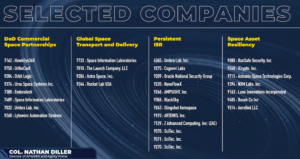
Gen. David Thompson
WASHINGTON: Financial instability caused by the COVID-19 pandemic is threatening the space supply chain, especially commercial startups that DoD has been counting on to bring both innovation and cost savings to future Space Force modernization efforts, frets Gen. DT Thompson, the newly confirmed vice chief of space operations.
“While we don’t expect to be anchor tenants, we can commit to being a part of a business base, [but] a lot of the rest of the business basis dried up as a result of the contractions that have occurred in the face of COVID. I’m very concerned about especially those small innovative companies,” he told a Defense One webinar today.
“I thought, you know, let’s say a year ago today, we were potentially on the cusp of an explosion in terms of what I’ll call opportunities presented by the creativity and the energy and the ingenuity in the commercial space mark,” Thompson explained. But now, that is in danger of slipping away — and DoD has yet to figure out how to help.
“I’m not sure yet if we figured out a way to ensure part of that will survive. If we do, it will serve us greatly. If not it may take us years to recover, back to the point where I think we were prior,” lamented Thompson, who was confirmed last night by the Senate for the vice chief slot and granted his fourth star.
One thing Space Force and DoD could do to help, Thompson said, is to improve how they communicate and contract with commercial space operators — for example, on provision of data relay capabilities, remote sensing and communications bandwidth.
“The other thing that … we need to work on, and this is work for us yet to do, is understand how to be able to communicate to that sector what our needs are, what our requirements are ,and what they could expect of us as a business base,” he said.
As an example, he said the Commercial Satellite Communications (SATCOM) Office, headquartered at Fort Meade, is “in the process right now trying to finalize the agreements that allow us to purchase data relay and communications and other services from any series of commercial providers in Low Earth Orbit. What we ought to be able to do is put those vehicles in place and send a signal to that commercial market sector that year in, year out of X number of years, you can expect the Department of Defense, including the US Space Force to be buying this this certain amount of services out of that market so they can count on it as a as a potential revenue stream.”
The same should be done for the small launch market, he said.
Clare Grason, head of the Commercial Satellite Communications (Commercial SATCOM) office, said back in March that her office was working on a new strategy to consolidate both military requirements and vendor contracts. The Transformative Acquisition Strategy, she noted, was initiated to help implement Space Force chief Gen. Jay Raymond’s Vision for SATCOM released in February.
At the time, Grason told me that the strategy would not exactly fulfill commercial industry’s hopes for a truly commercial acquisition model that would provide both vendors and customers with stable day-to-day access to bandwidth in the way a basic cable plan in the civilian world works. Instead, the idea was to set up the Commercial SATCOM Office as a kind of broker between customers and providers.

Winners of AFWERX Engage Space challenge
Thompson stressed that work on figuring out how to help bolster the commercial space industry and improve Space Force acquisition practices is being led by Air Force acquisition head Will Roper and DoD acquisition czar Ellen Lord. Space Force, he said, is “sharing ideas” about “how to incentivize and provide perhaps revenue streams and investments specifically in areas that we need.”
Another area being discussed is how the Space Force can help foster continued competition in the commercial market “on areas that allow that don’t automatically demand that we pick a winner” but where a robust competitive market would provide the military with advantages in future.
Indeed, the Air Force’s innovation hub AFWERX just yesterday wrapped up its EngageSpace event that brought together 175-plus teams, largely startups and small businesses, to offer innovative solutions to key space challenges, including improving resiliency of satellites and the overarching space architecture. As a result of the event, 26 companies were tapped for upcoming contracts of various types — for example, via Small Business Innovation Research (SBIR) funds.
Meanwhile, Thompson said, Space Force hopes to have its acquisition unit — Space Systems Command — stood up by next year. However, the Space Development Agency will not be included. As Breaking D readers know, the fate of SDA has been up in the air due to internal differences about how best to keep its focus on rapid procurement of innovative solutions.
Sullivan: Defense industry ‘still underestimating’ global need for munitions
National Security Advisor Jake Sullivan said that there are “no plans” for another Ukraine supplemental at this point.


























